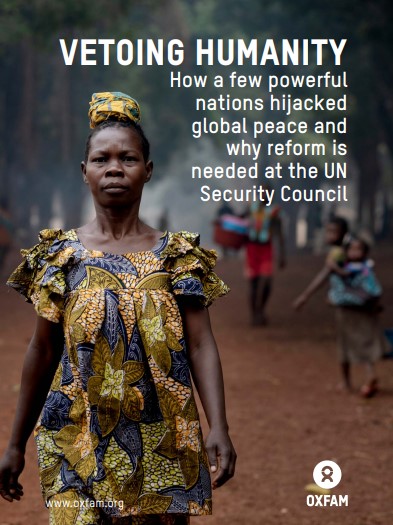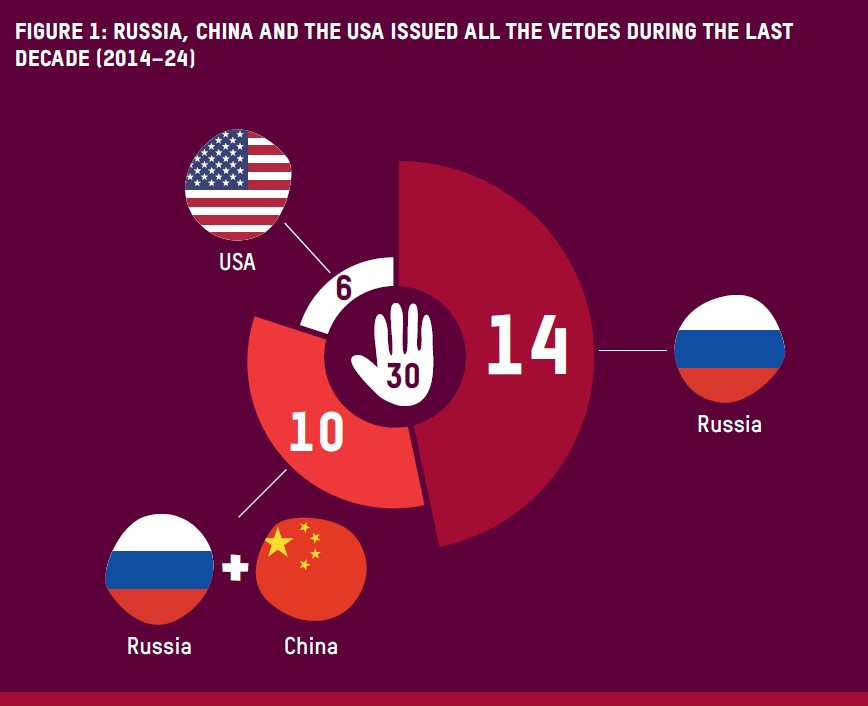Marc J. Cohen, Amy Croome and Elise Nalbandian introduce a new Oxfam report that sets out how the veto power of a few countries at the UN Security Council has been catastrophic for humanity. Ahead of next week’s landmark Summit of the Future, they demand four changes to reform a UN system that is simply no longer up to the challenge of maintaining international peace and security.

The promise of the United Nations Security Council (UNSC) to maintain international peace and security is broken. Conflict around the globe is rife. Dozens of conflicts have raged – some for decades – with no sign of abating, leaving an unprecedented trail of human suffering. The 23 protracted crises examined in this report have been included in the UN’s Global Humanitarian Needs Overview for at least five of the last ten years.1
Over the last decade alone, conflict has killed 1.1 million people in those 23 crises. Millions have been forced out of their homes, and conflict has been the primary driver of hunger – pushing 135 million conflict-affected people into severe hunger.2 During the same period, the number of people in need of humanitarian assistance has risen nearly four times, driving funding needs to nearly triple – from US$20.3bn to a staggering US$56.1bn – to address this escalation in human suffering.3
This is not a coincidence. A handful of powerful nations who represent only 25% of the world population, but hold its nuclear button, have too often manipulated the global peace and security system to meet their geopolitical and economic interests.
Between 2014 and 2024, one or more of the five permanent UNSC member states (the P5) vetoed 30 UNSC resolutions on protracted crises, including resolutions on the Occupied Palestinian Territory (OPT) and Israel, Ukraine, Syria and Yemen. Russia and the USA cast 75% of the 88 UNSC vetoes since 1989, with the rest by China – neither France nor the UK have used their veto power over that period.4 Many of the vetoes obstructed resolutions that were similar to those that overwhelmingly passed in the UN General Assembly (UNGA).
Moreover, the P5 have deliberately cherry-picked which conflicts to address in the Council. Over the last decade, over 95% of the resolutions that the UNSC passed relate to just half of the protracted crises, leaving the other half mostly neglected.5
How the gridlock has left so many nations in crisis, from Afghanistan to Yemen
The P5 are not homogenous: some of these influential countries have expressed openness to reform where others have – and continue – to use the veto in violation of the Charter’s own provisions. The gridlock within the UNSC has left the 23 crises discussed in this paper largely unresolved – namely those in Afghanistan, Burkina Faso, Burundi, Cameroon, the Central African Republic (CAR), Chad, the Democratic Republic of Congo (DRC), Ethiopia, Haiti, Iraq, Libya, Mali, Myanmar, Niger, Nigeria, OPT, Somalia, South Sudan, Sudan, Syria, Ukraine, Venezuela and Yemen.

As a result, local, women’s rights and feminist organisations, as well as NGOs and humanitarian and UN agencies, have struggled to respond to people’s immediate needs in these protracted crises. In 2023 alone, more than 100 million people could not be reached with protection and lifesaving food, water, sanitation and health assistance.7
Charting failures in Gaza, Syria and Ukraine
Oxfam’s Vetoing Humanity report illustrates how the current UNSC system is no longer fit for purpose. A handful of powerful nations have manipulated it to their own short-term political gains, resulting in a global humanitarian catastrophe that is now outpacing our ability to respond. Through three case studies – in Gaza, Syria and Ukraine – it shows how the P5 have not only failed to resolve these crises by abusing their veto and penholding powers, but have undermined the very goal of global peace and security that they first established.
The P5 provide far more military aid than humanitarian assistance.8 For example, in 2019, the USA provided US$18.8bn in security assistance but just US$6bn in humanitarian aid – and it was still the largest aid donor. While it may be argued that military aid fits into the P5 mandate of security, the imbalance between military aid and humanitarian aid is glaring. The P5 also overwhelming dominate the world’s legal arms trade, together accounting for 73.5% of sales.9 In 2021 alone, P5 arms exports totalled more than US$90bn, or enough to cover that year’s entire humanitarian funding gap of US$17.63bn more than five times over.10
The UN Summit of the Future must seize this chance for change
Ahead of the Summit of the Future, Oxfam urges the UN member states to use this ‘once-in- a-generation’11 opportunity to take decisive and bold action to rebuild a more equal, inclusive, efficient and responsive system, which truly captures the UN Charter’s ambitions and puts global peace above politics. This includes making the following changes:
- Renouncing the P5 veto and penholding monopoly and, instead, expanding membership to represent people and not military power.
- Permanent member states have a moral responsibility to uphold International Humanitarian Law and the Arms Trade Treaty,12 and stop arms transfers and military aid that exacerbate violence and suffering, and that are potentially used in committing war crimes.
- Women and other disadvantaged groups must be at the heart of peace negotiations: this is the only way to find inclusive and sustainable solutions.
- The international community must make humanitarian funding mandatory to create a humanitarian finance system that leaves no one behind.
The above blog is adapted from the executive summary to the report. Read the full report: Vetoing Humanity: How a few powerful nations hijacked global peace and why reform is needed at the UN Security Council
Endnotes
- In the annual Global Humanitarian Needs Overviews, published by the UN Office for the Coordination of Humanitarian Affairs (UNOCHA), 23 countries have been listed for at least five consecutive years in the last decade, and can thus be considered to have experienced a protracted crisis (definition by Development Initiatives). UNOCHA. Global Humanitarian Overview 2024. Accessed 22 August 2024. https://humanitarianaction.info/; and https://www.unocha.org/publications/report/world/global-humanitarian-overview-2024-enarfres
- FSIN. (2024). 2024 Global Report on Food Crises: Joint analysis for better decisions. Accessed 22 August 2024. https://www.fsinplatform.org/sites/default/files/resources/files/GRFC2024-full.pdf
- Humanitarian Action. (2023). Global Humanitarian Overview 2024. Accessed 22 August 2024. https://humanitarianaction.info/document/global-humanitarian-overview-2024/article/response-plans-overview-2024 .For funding appeals data 2014 and 2023 see UNOCHA Financial Tracking Service (FTS). (n.d.). Historical Coverage of Coordinated Plans: Humanitarian aid contributions 2023. Accessed 20 July 2024. https://fts.unocha.org/home/2023/plans
- For details on UNSC vetoes, see UN Dag Hammarskjöld Library. (n.d.). UN Security Council Meetings & Outcomes Tables: Veto List. Accessed 20 July 2024. https://research.un.org/en/docs/sc/quick
- Oxfam calculations based on UN data. For 2024 see UNSCR. UN Security Council Resolutions. Assessed 12 September 2024. https://main.un.org/securitycouncil/en/content/resolutionsadopted-security-council-2024 . For 2015-2023 see UNSCR. UN Security Council Resolutions. Accessed 22 August 2024. http://unscr.com/
- UN Dag Hammarskjöld Library. (n.d.). UN Security Council Meetings and Outcomes Tables: Veto List. Accessed 20 July 2024. https://research.un.org/en/docs/sc/quick
- UNOCHA. (2022). Global Humanitarian Overview 2023. Accessed 22 August 2024. https://www.unocha.org/publications/report/world/global-humanitarian-overview-2023-enaresfr
- SIPRI. (2024). SIPRI Yearbook 2024, Armaments, Disarmament and International Security (p.11). Accessed 20 July 2024. https://www.sipri.org/sites/default/files/06-2024/yb24_summary_en_1_2.pdf ; UNOCHA Financial Tracking Service (FTS). (2024). Total Reported Funding 2021. Accessed 28 August 2024. https://fts.unocha.org/globalfunding/donors/2021?order=total_funding&sort=desc
- P.D. Wezeman, K. Djokic, M. George, Z. Hussain and S.T. Wezeman. (2024). Trends in International Arms Transfers, 2023. Stockholm International Peace Research Institute (SIPRI). Accessed 22 August 2024. https://www.sipri.org/sites/default/files/2024-03/fs_2403_at_2023.pdf
- X. Liang, L. Scarazzato, L. Béraud-Sudreau, N. Tian, D. Lopes da Silva, Y. Choi and E.K. Sild. (2023). The SIPRI top 100 arms-producing and military services companies, 2022. SIPRI. Accessed 28 August 2024. https://www.sipri.org/sites/default/files/2023-11/fs_2312_top_100_2022.pdf
- Summit of the Future. (2024). Accessed 22 August 2024. https://www.un.org/en/summit-ofthe-future
- UN. The Arms Trade Treaty. Accessed 28 August 2024. https://www.thearmstradetreaty.org/ hyper-images/file/TheArmsTradeTreaty1/TheArmsTradeTreaty.pdf UNOCHA. (2013). Global Humanitarian Overview 2014. https://reliefweb.int/report/world/overview-global-humanitarian-response-2014-enfres#